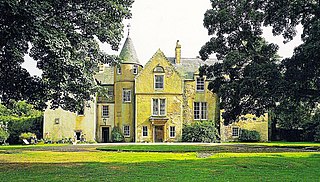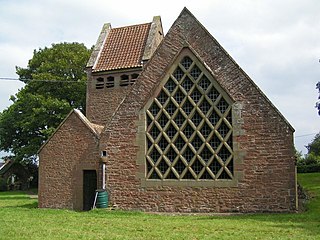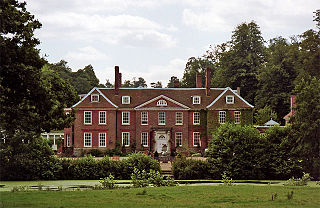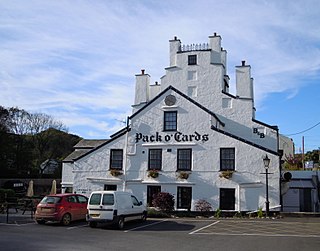
Robert Devereux, 2nd Earl of Essex, KG, PC was an English nobleman and a favourite of Queen Elizabeth I. Politically ambitious, and a committed general, he was placed under house arrest following a poor campaign in Ireland during the Nine Years' War in 1599. In 1601, he led an abortive coup d'état against the government of Elizabeth I and was executed for treason.

Compton Wynyates is a Tudor country house in Warwickshire, England, a Grade I listed building. The Tudor period house is constructed of red brick and built around a central courtyard. It is castellated and turreted in parts. Following action in the Civil War, half timbered gables were added to replace damaged parts of the building.
Elsyng Palace was a Tudor palace on the site of what are now the grounds of Forty Hall in Enfield, north London. Its exact location was lost for many years until excavations were carried out in the 1960s.

East Horndon is a village and former civil parish, now in the parish of West Horndon, in the south of the borough of Brentwood in Essex in the East of England. It is situated just south of the A127 road near Herongate. The village Church of All Saints is located to the north of the A127, and is redundant, but in the care of the Churches Conservation Trust. In 1931 the parish had a population of 440.

Coughton Court is an English Tudor country house, situated on the main road between Studley and Alcester in Warwickshire. It is a Grade I listed building.
Sir Arthur Harris of Creeksea Place in Essex, England, served as High Sheriff of Essex in 1589, a Justice of the Peace, and one of the Commissioners appointed in 1577 to enquire into piratical practices along the Essex coast.

Ingatestone Hall is a Grade I listed 16th-century manor house in Essex, England. It is located outside the village of Ingatestone, approximately 5 miles (8.0 km) south west of Chelmsford and 25 miles (40 km) north east of London. The house was built by Sir William Petre, and his descendants live in the house to this day. Part of the house is leased out as offices while the current Lord Petre's son and heir apparent lives in a private wing with his family. The Hall formerly housed Tudor monarchs such as Queen Elizabeth I.

Chenies Manor House in the parish of Chenies in Buckinghamshire, England, is a Tudor Grade I listed building once known as Chenies Palace, although it was never a royal seat nor the seat of a bishop. It was held by the Cheney family since 1180 and passed by marriage successively to the Semark and Sapcote families and thence in 1526 to the Russell family, Earls of Bedford, later Dukes of Bedford, by whom it was held for several centuries. Although the Russells soon abandoned Chenies as its main seat in favour of Woburn Abbey in Bedfordshire, Chenies parish church remains the site of the private "Bedford Chapel", the mausoleum still in use by that family.

Keith Marischal is a Scottish Baronial Country house lying in the parish of Humbie, East Lothian, Scotland. The original building was an "L-shaped" Tower house, built long before 1589 when it was extended into a "U-shaped" courtyard house. The building acquired its modern appearance in the 19th century when the courtyard was filled in. The house is protected as a category B listed building.

Sutton Place, 3 miles (4.8 km) north-east of Guildford in Surrey, is a large Grade I listed Tudor prodigy house built c. 1525 by Sir Richard Weston, a courtier of Henry VIII.

Cockfield Hall in Yoxford in Suffolk, England is a Grade I listed private house standing in 76 acres (31 ha) of historic parkland, partly dating from the 16th century. Cockfield Hall takes its name from the Cokefeud Family, established there at the beginning of the 14th century. It was purchased by Jon Hunt in 2014 to form part of his Wilderness Reserve offering exclusive rural holiday accommodation.

Albert Randall Wells (1877–1942) was an English Arts and Crafts architect, designer, craftsman and inventor.

Creeksea is a village and former civil parish, now in the parish of Burnham-on-Crouch, in the Maldon district, in the county of Essex, England. It is on the Dengie peninsula on the north side of the River Crouch, one mile west of Burnham-on-Crouch. In 1931 the parish had a population of 76.
Sir William Harris was an English knight, land owner, and a notable incorporator in the third Virginia Company of London.

Berkhamsted Place was an English country house which was erected sometime around 1580 in Berkhamsted, Hertfordshire, England. It was built by Sir Edward Carey, the keeper of the Jewels to Queen Elizabeth I from stones removed from Berkhamsted Castle. Several notable residents of Berkhamsted lived in the house and over the years its owners welcomed guests such as King Charles I and William Gladstone.

Chilston Park is a country house in Boughton Malherbe, Kent, England. Started in the 15th century, the house has been modified many times and is a Grade I listed building, currently operated as a country house hotel.

Ewenny Priory House is a privately owned Georgian mansion located immediately to the south of Ewenny Priory church, at Ewenny, Vale of Glamorgan, Wales. Originally built in 1545 it was rebuilt in the early 1800s. The house is Grade II* listed.

The Pack o' Cards is a historic house built about 1690 in Combe Martin in North Devon. Today it is a public house and hotel. It is listed Grade II* on the National Heritage List for England.
Green Street House, usually known as Boleyn Castle, was a stately home in East Ham in the modern London Borough of Newham, East London.

The Church of St Mary the Virgin in Pilton is the 13th-century Anglican parish church for the Pilton suburb of Barnstaple in Devon. It has been a Grade I listed building since 1951 and comes under the Diocese of Exeter.

















